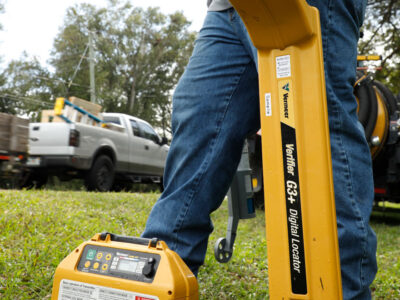Equipping HDD crews with an accurate utility locator and making sure they know how to use it goes a long way in helping verify metallic and conductive underground lines, but what about non-metallic and non-conductive utilities like water, sewer and drain lines? To identify the specific location of these buried utilities, contractors should be using utility probes, or sondes, in conjunction with a utility locator.
Utility probes are an accurate way to track the path of non-conductive utility lines made of concrete, plastic or clay. Crews have to push the probe through an existing utility duct from a manhole or hand-hole entry point. The utility locator can then follow the path of the radio-transmitting probe from above ground. It’s a quick and accurate way to pinpoint the location and depth of these utilities, which can help reduce the risk of striking or intersecting with another underground line while boring.
Utility probes prove invaluable for this contractor
Mike Carway with Nextier Infrastructure Solutions and his crews have been using Vermeer utility probes for several years. He said he couldn’t imagine life without them. “Too many contractors take unnecessary risks by not doing an efficient job of verifying locates,” he explained. “That lack of professionalism gives the whole industry a black eye. I think the reason some companies choose to cut corners is because verifying the location of utilities can be labor intensive and time consuming. Using probes in conjunction with our Vermeer® Verifier G3® locator, we’ve been able to cut the amount of time we spend potholing in half on a lot of projects in urban areas. Probes save time and are easy to use.”
Nextier performs almost 90% of its work around downtown Atlanta, Georgia. With all the concrete around, potholing to verify underground utilities can be a significant challenge. Using multiple Vermeer probes that vary in diameter and length, the Nextier team uses underground access points in manholes and hand-holes to gain access to utility ducts.
“It’s not uncommon to open a manhole and see 12 different duct openings,” Carway said. “We identify any vacant ones and run the probe through it. That way we know exactly where those lines go, which helps reduce the number of utilities we need to expose before completing a bore.”
How can a utility probe help your operation?
Carway has had several contractors ask him about utility probes. When he explains the process and efficiency of it, they usually go out and buy one. “Any utility contractor not using probes either doesn’t know they exist or just wants to make their crew’s job harder than it has to be, as far as I’m concerned.”
Talk to your Vermeer dealer to learn more about using utility probes.
This article contains third-party observations, advice or experiences that do not necessarily reflect the opinions of Vermeer Corporation, its affiliates or its dealers. Testimonials and/or endorsements by customers in specific circumstances may not be representative of normal circumstances experienced by all customers.
Vermeer MV Solutions, Inc. reserves the right to make changes in engineering, design and specifications; add improvements, or discontinue manufacturing at any time without notice or obligation. Equipment shown is for illustrative purposes only and may display optional accessories or components specific to their global region. Please contact your local Vermeer dealer for more information on machine specifications. Vermeer, the Vermeer logo and Verifier are trademarks of Vermeer Manufacturing Company in the U.S. and/or other countries. © 2023 Vermeer MV Solutions, Inc. All Rights Reserved.
